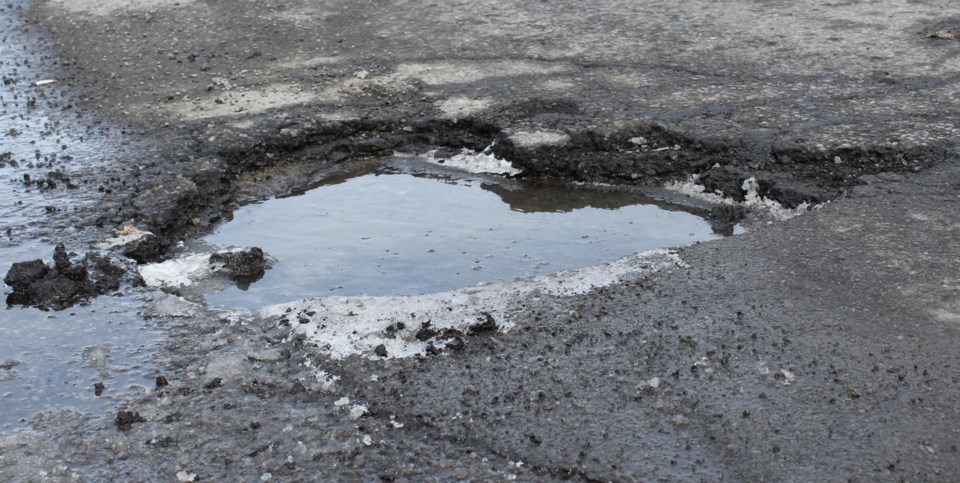For most people, unusually warm days in winter are a welcome relief from bitterly cold temperatures.
But for Greater Sudbury's roads maintenance staff, the yo-yoing temperatures lead to an unhappy phrase: freeze-thaw cycles. When streets thaw and then freeze in winter, the result is potholes. And in a city where complaining about the state of the roads is a municipal pastime, that's bad news.
Warmer temperatures in recent years – locally and globally – is generally attributed to climate change. While the average temperature in Greater Sudbury for December is -8 C, it has been warmer than that every year since 2010, except for 2013 and 2017. In 2015, the average was -1 C. January has also been warmer in the same period compared to the -12 C average we normally receive.
Within those warming temperatures are bigger spikes in highs and lows – last December we saw highs of 5 C and lows of -21 C. So far in January, we've seen temperatures anywhere between 1 C and -26 C.
“It's the perfect recipe for potholes,” said Tony Cecutti, the city's GM of infrastructure, of the fluctuating daily highs and lows. “When your average daytime temperature is (above 0 C), you know things are going to freeze overnight.”
It's the perfect conditions for potholes and other road damage, Cecutti said, because the pools of water that form during the day on the road seep into the asphalt, then freeze when it gets cold. The asphalt is forced to expand when the water freezing, creating cracks that get worse when the freeze-thaw cycle is repeated again.
The hard winter months are the worst time, because the gravel under the road is frozen.
“That's why, typically, you're not going to see it in the fall because the gravel still a little bit warm, so that water soaks into the gravel and disappears. But as winter drags on, that top layer of asphalt heats up and allows the water to penetrate and it sits on top of the frozen gravel.”
Traffic worsens the damage, and over time, a pothole emerges.
“The weather (Monday) was perfect for the start of the formation of potholes,” Cecutti said. “We had a significant snow accumulation. We've got melting snow, big snow banks, a bit of salt in the snowbanks. So water's getting onto the road and it's supposed to get really cold tomorrow, right?”
When winter road crews aren't plowing, Cecutti said often they're out working on pothole repair. While temporary repairs are common in winter — because it's hard to get hot asphalt to cure properly in winter when it's so wet – he said they are using newer products that last longer.
“We use all kinds of different materials,” he said. “We continue to experiment with new products (and) there's polymer modified materials in all the material we use.”
For example, they used a special asphalt hot mix in the recent repair of a large watermain break on Larch Street at Christmas. And the city has a “hot box” on site repair where they use a mix of new and old asphalt to fix potholes.
“It's a better quality product for sure,” he said. “But anytime you're doing work in the winter, it's virtually impossible to get all the moisture out of the ground. Any repair that you do in the winter is somewhat temporary and has a higher risk of falling apart through the winter season.”
It's an issue the city has traditionally dealt with in March, when the changing season means some days are cold, others are warm. But Cecutti said climate change, and the fluctuating temperatures it brings, means pothole season is a lot longer now.
“With climate change, the frequency of pot holes, well, we had issues in December and now it's January we having issues right?” he said. “I remember as a kid, when it got to be a winter, it stayed winter. You're not going to get a lot of water penetrating into the roadway when it's 28 degrees below zero.”
The city's winter pothole repair budget reflects that, ranging from $200,000 to $1 million in recent years, depending on the weather.
Globally, there have been several studies on the impact of climate change on road asphalt, particularly in northern cities. One study, by the World Road Association, found that increasing freeze-thaw cycles is a global concern.
“Over 50 per cent of the distresses on Canadian roads are attributed to freeze-thaw cycles,” the study concluded. “Milder winters, along with higher frequency freeze-thaw cycles, will accelerate road deterioration and increase maintenance costs.”
The study argues that cities should look to build roads based on the expected effects of climate change, rather than rely on historic data.
“This type of analysis would allow a better understanding of the potential influence of future increases in rutting, freeze-thaw cycles, frost heave and thermal cracking on the functional life of the pavement.”
While solutions are still far off, Cecutti said it's important for residents to be aware that winter potholes are now part of the challenges of driving in cold months, and drivers should take extra caution. And if you see a pothole, call 311 to report it.
“In any northern community that's exposed to winter conditions, you're going to be dealing with these things,” he said. “We know (fixing potholes) is an important part of what we have to do, and we take that role seriously. But sometimes the community sees them and thinks that we're ignoring it. We're not.
“We monitor them and we fix them when when we have crews available. We know it's important for us to be doing that so that people can get around the city.”
